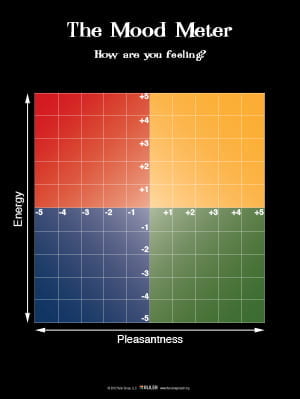In the first few days of school, students flooded into their homerooms to see their friends and meet with their homeroom teacher before continuing to their normal classes. This year, however, each homeroom was instructed to discuss a central topic: how do students truly feel at THS, and how is that different from how they want to be feeling? Most students said they felt negative at school – tired, sad, stressed. Furthermore, most students reported that they wished they felt happy, successful, and energized, among other positive emotions. These discussions led to the creation of a school-wide charter.
 In addition to the charter, students also took an in-depth look at a “mood meter”, a coordinate graph with four quadrants of colors designed to help students identify their emotions based on their energy level and the positive and negative aspects of one’s emotions, in their English classes. Each student was given their own mood meter and tasked with associating different emotions with objects, people, emojis, music, or even events in their own lives. These two emotional tools help students to identify their feelings and work towards creating a more positive environment in the school.
In addition to the charter, students also took an in-depth look at a “mood meter”, a coordinate graph with four quadrants of colors designed to help students identify their emotions based on their energy level and the positive and negative aspects of one’s emotions, in their English classes. Each student was given their own mood meter and tasked with associating different emotions with objects, people, emojis, music, or even events in their own lives. These two emotional tools help students to identify their feelings and work towards creating a more positive environment in the school.
The two emotional tools were introduced by Mrs. Avcollie and Mr. Vigliotti. They were derived from the RULER program at the Yale Institute of Emotional Learning. “The charter and the mood meter are two of their four anchor tools developed to help people recognize the role that emotions play in our life,” explained Mr. Vigliotti.
Avcollie and Vigliotti’s goal in implementing these two tools was to aid in the development of self-management skills and helping students recognize the role that emotions play in how they learn and in their development.
“Research shows that most students feel tired, stressed, and bored in school. This is the reality of how people feel. We know students won’t always be happy and we need to recognize that and recognize how it impacts students. We want to empower each other to feel more positive, which in turn will make us more available and more capable,” Mr. Vigliotti continued.
Each of these objectives falls under the district-wide initiative of Social Emotional Learning (SEL), an initiative that strives to assist students in recognizing that labeling and regulating emotions is as important as their academics.
Mrs. Avcollie described the goals as “providing a common language for students to utilize when they express their feelings.” She continued on, explaining just how the administration was going about this: “At the district level, we are creating methods to monitor and support the implementation of the charter and mood meter, as well as professional learning and implementation of future SEL goals. At the high school level, the high school team looks for ways to implement SEL authentically.”
Introducing new tools for high school students to deal with emotions is always a difficult thing to do. Often being cynical, most students tend to believe that such things are pointless. Although the mood meter and school charter might seem corny, at the core they can serve as important and helpful tools. That being said, the high school team is continuing to work towards improving their implementation of tools for the SEL objectives.
Though every student technically participated in making the school charter and making their own mood meter, many students reported feeling confusion as to the purpose of these tools in their own education. Mr. Vigliotti expected this, describing that “I think making a charter and introducing the mood meter was the easy part. We hit the roadblock of ‘how do we live these things and how do we make students feel like this is something that works, not something that is being forced on [them]?’”
“We’ve only spent a few days working on [the mood meter and school charter], and I have not seen [them] being incorporated into my education, with the exception of health class,” said freshman Azayda Lynt. Students like Azayda are easily skeptical about the purpose and effectiveness of the tools introduced into THS. Other students, however, feel optimistic that the tools are a step in the right direction. Tyler Mendela, a junior, conveyed that he believed the move towards working on SEL with students was an important step for the community.
When asked about his view on how these tools have been received so far by the student body, Mr. Vigliotti explained, “I think it is too early to see the impacts. We have plans to receive more meaningful feedback. We want it to be useful. At this point, I’m not prepared to say whether it’s making a difference or not – it’s also something that’s very hard to measure.”
Written by Jade Ockenfels

